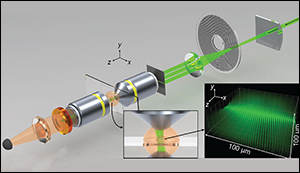Fluorescent holography - Upending the world of biological imaging
26. 10. 2016 | Colorado State University | source.colostate.edu
Optical microscopy experts at Colorado State University are once again pushing the envelope of biological imaging. They have designed and built a fluorescence-detection microscope that combines three-dimensional and high-resolution image processing that’s also faster than comparable techniques.
This new microscope builds upon a previously published technique, and permits digital re-focus of fluorescent light. It illuminates not one point, but multiple points by harnessing delocalized illumination spread over a large area. The physical principles they are using are similar to holography, in which scattered light is used to build a 3-D image.

Using a large illumination field, followed by back-end signal processing, the microscope can define distinct light modulation patterns of many points within the field of view. It builds up a 3-D image by combining the signals from all those distinct patterns.
What does this new technique allow? Deep-tissue images in three dimensions, with better depth of field than comparable techniques. Depth of field, like in photography, means background images are in sharp focus along with the main image. And the CSU researchers can work at 600 frames per second, which is many times faster than established techniques.
Read more at Colorado State University
Image Credit: Colorado State University
-jk-




